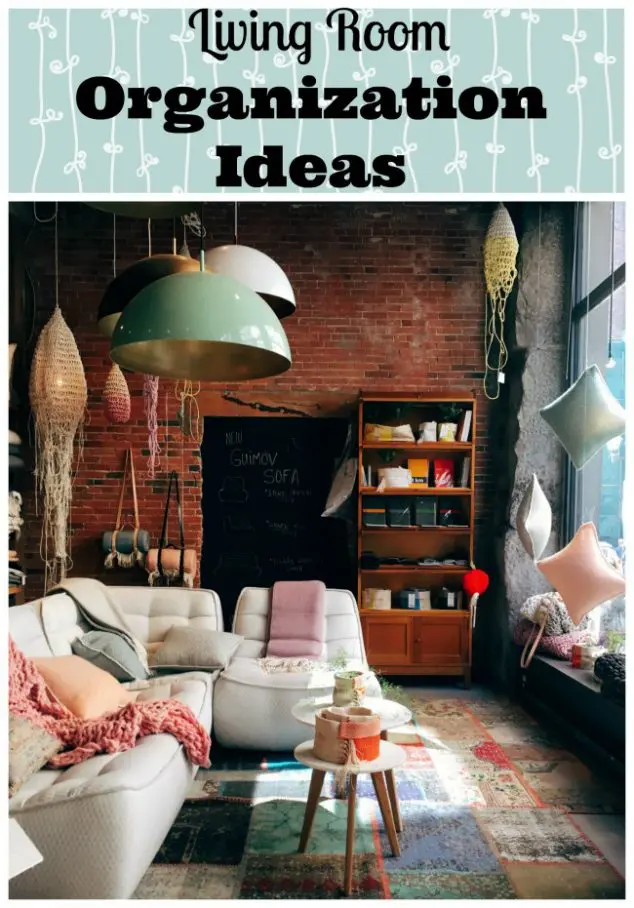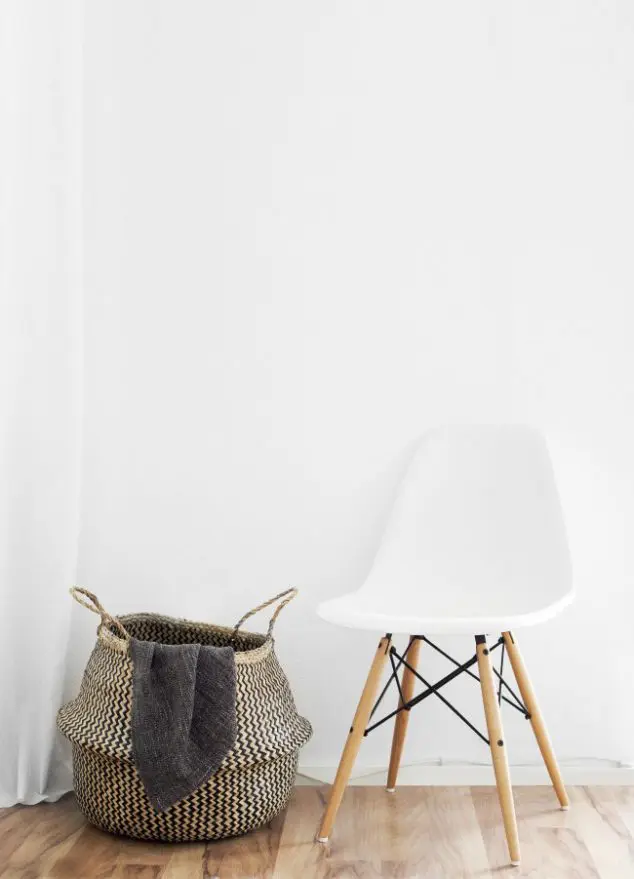Tired of tripping over your kids toys? Overwhelmed by the sight of stuff everywhere? Well, today I have organizational experts to share with us living room organization ideas you will love. The Pixies, Kelly and Katie McMenamin, just released a new book. It teaches you room-by-room solutions according to your own unique personality! It is called ORGANIZE YOUR WAY: Simple Strategies for Every Personality. I have included an amazon affiliate link here for your convenience. I also get to share a really helpful excerpt with you with awesome storage solutions so you can have an organized living room too!
Kelly and Katie have helped a wide range of clients, from multi-millionaires with household help to stay-at-home moms trying to stay ahead of the multiplying toys. They even have a fun quiz to help you determine your organizational personality type! You are going to love these professional organizer easy ways to organize even a small living room.
10 Awesome Living Room Organization Ideas:
Thanks so much toKatie McMenamin & Kelly McMenamin as well as Sterling Publishing for allowing me to share this excerpt on living room organization ideas from ORGANIZE YOUR WAY: Simple Strategies for Every Personality.
Reprinted with permission from Organize Your Way (c) 2017 by Katie McMenamin & Kelly McMenamin, Sterling Publishing Co., Inc.
UNIVERSAL SOLUTIONS, Family and Living-Room Essentials for All Types
- Limit how many purposes these rooms serve.
- Ensure that multipurposes are separate and conducive to each other.
- Create a classic U-shaped conversation pit.
- Your TV doesn’t have to be a focal point.
- Have enough storage and tables.
- Declutter and digitize.
- Create a wall photo gallery.
- Hide toys.
- Only hardcover books belong in these rooms.
Limit Multipurpose
Living areas are often multipurpose rooms—TV room, kids’ playroom, and/or home office—and in serving many masters they can easily accumulate unnecessary clutter, which is a bummer since they’re also the place where guests spend the most time. How to keep clutter to a minimum? Minimize multipurposes.
If this isn’t possible because of your irregular shaped living room, then make sure the multipurposes are distinct yet conducive to each other—i.e., put a home office in a corner that isn’t part of the main seating area, and make sure it matches the décor. A work desk should only hold office stuff, not DVDs or a game console. Office supplies and toys need proper, permanent, hidden homes so that you can completely close up the office or playroom when it’s time to be an adult or entertain. Think: armoire desk with a hidden shelf or drawer for a printer, dedicated toy shelves with multiple opaque toy bins behind a couch, coordinating fabric panels that hide office and toy paraphernalia. Sipping a drink next to a printer the size of Gibraltar would be off -putting to anyone.
Your furniture layout
Outside of clutter, the biggest complaint we hear about living areas is that nobody hangs out or interacts in them. The solution is usually as quick as rearranging your existing furniture so the layout is conducive to both conversation and relaxation. For this to happen, you need a U-shaped conversation pit around the couch (e.g., a couch with two chairs opposite it or o to the side). Adhering to proper furniture layouts like this helps rooms function better. It’s one of the best lessons in Lauri Ward’s book for a reason.
We implemented this idea for a client who had a hair studio just off her living room. Within minutes of placing two dining chairs opposite her couch, the three men waiting in silence to get their haircuts started jabbering away like old friends. This taught us that it’s not as much about the comfort of the chairs opposite the couch as it is about the U-formation. Avoid an L-shape—a couch with one chair or a chaise sectional—but if this is your setup, get at least one occasional chair or stool to turn the “L” into a “U.” Custom size rugs made to order can also be used to visually transition an L-shape into a U-shape setup. Someone will use it—we promise!
Also, one of the most common mistakes people make in this room is having seating too far away from their coffee table: Eighteen inches (46 cm) is the best distance. The best sofa seat height is around sixteen or seventeen inches (40–43 cm), and the coffee table should be roughly the same height.
TVs are eyesores
As for your televisions, don’t hate us, but they really shouldn’t be blocking windows. Make sure they are roughly at eye level when you’re seated—it’s hard to relax and watch the boob tube when you’re craning your neck. If you’ve only got one living area, the TV shouldn’t be the center of attention. Search “Hide TV” on Pinterest to find clever places and ways to hide a television.
The best solution is to build a whole unit around the television so it’s not one lonely, massive, ugly centerpiece. A cheaper option is “minimizing” a television by surrounding it with pictures. The television eyesore then becomes one picture among many in a gallery! Or you can paint the TV wall dark. Worst case: hang it over the replace with a special mount, and keep the cable box and modem in a media cabinet nearby. But if you’re hanging it, make sure it’s situated roughly six to eight inches (15–20 cm) above a piece of furniture (ditto for paintings).
Everybody has extra, unused wires and items in their TV area. Sometimes it’s a comical tangled mess. At a minimum, make sure these ugly items are behind cabinet doors or in a bin.
Have adequate storage and surface space
Everyone needs a media console to store unsightly cords, video games, cable boxes, and so on—and not some horrid metal-and-glass contraption that shows off a fancy amplifier and receiver and surround-sound speakers. Your television console—especially if it’s in your only formal living room—should be a nice piece of furniture at least as big as your television, with hidden space for utilitarian electronics. Infrared devices enable you to hide these without rendering them useless or hard to reach. Your best bet is to buy a media console that sur- rounds the television with shelving and cabinet storage to draw attention away from the eyesore. Plus, you get the bonus of extra storage—always wise—to accommodate all the random bits and bobs that sneak into this room.
Having matching daylight lamps and side tables on either side of the couch improves the functionality of these rooms. We also find that many clients don’t have large enough coffee tables or ottomans, with trays substituting as such. To figure out if they’re big enough, imagine being a guest in your own home. Sit down in all the available seats and ask yourself where you would put down your glass. Can you reach the nearest surface without having to stand up?
Ditch clutter you don’t love
Oh, and then there are all those decorative items, picture frames, magazines, catalogs, DVDs, and so on. Make sure you love all your random things and that they fit with the living room’s décor. Magazines should be current, few, and stored in a separate container. The same goes for catalogs. Less clutter makes a huge difference!
Digitize
Digitize your music and DVD library so you have your favorite tunes, movies, and TV shows stored in the cloud and not your living area. Either do the project yourself over time, or hire someone to do it for you. As a bonus, it allows you to watch movies on multiple devices—not just the TV with the disc player.
Speaking of digitizing, many people keep family albums in their living areas. If you have shoe boxes full of old photos, it’s easier to play catch-up on making albums when photos are digitized. You can digitize photos using a bulk mail service or, if you’re concerned about the safety of your collection, there are organizers you can hire who specialize in organizing photos and making albums for you. No joke. In the words of our favorite photo organizer, Isabelle Dervaux, “Enjoy your photographs—don’t stash them away.”
Create a wall photo gallery
Another common problem in living and family rooms is the ever-present hodgepodge of photo frames. Slowly but surely, people give them to you, and then before you know it your side tables, bookshelves, and mantel are all covered. Clear frames off utilized surfaces, like side tables and bookshelves, and find spots for them that are not blocking the utility of furniture. The best way to do this is to create photo-gallery walls with matching or coordinating matted frames in your underutilized hallways or staircases. You can get great affordable pre-matted frames from Pottery Barn or West Elm® that often come with templates and design suggestions for how to arrange them.
Hide the toys
If, God forbid, you have to share your living area with toys, then think about positioning your couch so that the toy storage is hidden behind it. Couch tables with cabinets and shelves are perfect additional storage space for toys in multipurpose living areas.
Books happen—here’s how to deal
Even with the advent of e-books and the cloud, and while we find fewer and fewer DVD and photo- album collections in the course of our work with clients, every type seems to hang on to their books (even textbooks). Especially if you’ve merged your household with someone else’s or were raised by a bibliophile.
To reduce clutter on living-room bookshelves, we suggest a hardcover-only rule in here. Consider keeping paperbacks book collection in the family room or bedroom, where there are not as many prying eyes. Paperbacks are meant to be recycled unless they are truly out of print or still read. Donate hardcovers you don’t care about anymore. Let that poor neglected book be loved by someone, man! Keep only books that have meaning, that you read, that make you happy, or that frankly look good in a display. Once you take these steps, your books become more like objets d’art than utilitarian fountains of knowledge.
Avoid placing photos and tchotchkes in front of books. It makes retrieving them into a three-step process, but if you’re lacking space and keep the books more for décor than reading, it’s okay. If you want bookshelves to look even less cluttered, let go of the dust jackets. You can still organize books by subject. To take it a step further, organize books by color and size within their subject matter. Break up the long lines of vertically stacked books with a horizontal stack here and there and/or a few photographs. You can sometimes even get away with putting a photo or tchotchke on top of a small pile of horizontally stacked books. Your guests will be impressed the next time they see this artful display of books interspersed with your choicest tchotchkes and photographs.
Conclusion
I hope you have enjoyed these living room organization ideas from ORGANIZE YOUR WAY: Simple Strategies for Every Personality. Implementing these ideas can go along way from taking a toy strewn living room and making it look magazine worthy! You are going to love having a tidy living room. Which living room organization ideas will you work on first?
Related Posts:



